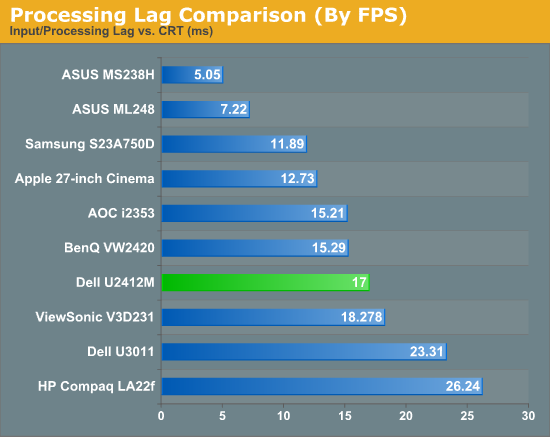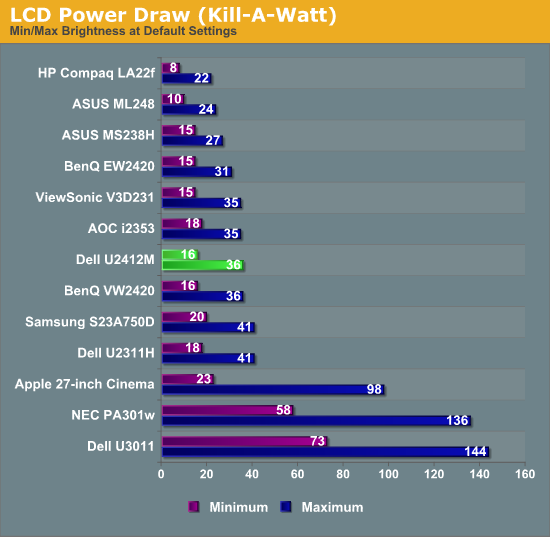Dell U2412M - 16:10 IPS without Breaking the Bank
by Chris Heinonen on February 28, 2012 9:00 AM ESTDell U2412M Input Lag and Power Use
For testing lag, I am trying a new solution to our previous testing method. I’m trying out SMTT, which is designed specifically for measuring lag in LCD displays. Using DirectX it manages to push over 1,000 frames per second to a display, allowing for millisecond accuracy instead of relying on time demos that often run well below that threshold. Using this method, we can actually determine two different values: The input lag for the LCD to initially respond, and then the total lag from when the new frame is received to when it is completely drawn and at full brightness. This last one is the overall important value, as it is what gamers would be most concerned with. It’s important to have as low an "input lag" as possible so that even if the screen isn’t fully drawn yet (the pixels will be changing over) you will be able to begin to get that feeling of responsiveness.

Here we see that the overall lag value measured OK, at 17ms. The input lag, which was also measured, was just under 2ms, which indicates that the Dell responds very quickly, and then it’s just a matter of the pixel response time. One thing to keep in mind here is that the 17ms response time is the total time from input to peak brightness, and then it takes 15ms to fall back to another value. When I actually look at the test subjectively and not objectively, you can certainly see the change in the pixel after 7-8ms of time. So I could report it as 8ms of lag, as that’s about what I think you would experience in a real world situation, but the worst case scenario seems to be 17ms, which is what I’m choosing to report as that’s the objective number.
The CRT still comes in perfect, and that’s what the LCD should aim to do; picking a number that gives a better result, even if it might be more applicable to the real world, feels like cheating. Perhaps we will get a future display technology (like OLED or CrystalLED that I saw at CES this year) that will bring us back to CRT response times, but until that happens I’m going with the objective, worst case measurement. I will report the “real world estimate” along with it, though, so you can use that for your own judgment. Please let me know what you think of this in the comments section.
I made the assumption that with a larger panel and the 300 nits of light output that the Dell would not be the most eco friendly panel I had seen. Happily I found this to not be the case. It drew just 36 watts at maximum brightness and only 16W at minimum brightness, less than even the 23” Dell U2311H from last year. I don’t know if it is more efficient LED lights, or a more transparent panel that allows more light through, but Dell did a good job keeping the power use low on the U2412M.











143 Comments
View All Comments
DarkUltra - Tuesday, February 28, 2012 - link
- I know that as soon as I check the comments there will be a thread with the same theme: “I don’t care about 1080p monitors, I only want 16:10 aspect ratios!”And don't forget the 120hz thread! You really should mention 120hz in your reviews, it should affect the manufacturers and readers so we can move to this new standard. Even as slow as 8ms gtg response time will benefit as 1000/120=8,33. The pixels change sooner, too. But lower response time will make things look sharper when they are moved around.
DarkUltra - Tuesday, February 28, 2012 - link
120Hz will drastically improve your desktop and gaming experience. Here is a few reviews and testimonies.- Wonder in amazement as the 120Hz display produces an easily observable higher fluidity in the animation.
techreport.com/articles.x/21516
- The ASUS VG236H was my first exposure to 120Hz refresh displays that aren’t CRTs, and the difference is about as subtle as a dump truck driving through your living room. www.anandtech.com/show/3842/asus-vg236h- review-our-first-look-at-120hz
- Doing precise image editing, as another example, is an area where faster display processing times are desirable. www.anandtech.com/show/2787
- 120hz lcd Smoother motion and the lack of RTC artifacts leave a highly positive impression, making you unwilling to return to 60Hz. www.xbitlabs.com/articles/monitors/display/ samsung-sm2233rz_5.html
- I ran Fraps and found using the display’s 120hz mode that once the framerates were up above 80 there is an amazing solidity and 3d- like quality to the gameplay. Once the framerate hits 100+ – well, the effect has to be experienced to understand it. hardforum.com/showthread.php? t=1486357&page=4
- I saw a 120hz monitor at my local MicroCenter and was totally amazed by how smooth the mouse moved on the desktop, makes my 60hz monitor looks absolutely dated. http://hardforum.com:80/showthread.php?t=1466381&a...
jooh.no/index.php/2012/01/05/lg-w2363d-120hz-monitor/
Sabresiberian - Tuesday, February 28, 2012 - link
Very nicely written, thanks Dark!colonelclaw - Tuesday, February 28, 2012 - link
Meh, so now I want 120Hz too.Any news on whether 16:10 IPS panels are headed towards 120Hz?
peterwargo - Tuesday, February 28, 2012 - link
I just bought one of these last week when there was a good discount code available from Dell. I've been looking for years for a decent 24" 16:10 screen for my Mac Pro, as my aging Samsung isn't really that happy anymore. But I love the form factor, and being visually-handicapped, good contrast control and clarity are a big deal for me.I'm a Mac user 90% of the time, but I've never been happy having had both the 24" and 27" LED cinema displays on my work machine. The glare is annoying, and I'm really cheesed off at Apple for providing only one input (MDP) and a short cable as well. Then, there's the price.
Frankly, I'm in love the this screen. The anti-glare is excellent, and the contrast is every bit as good as the Apple screens (tried 'em side-by-side). Additionally, the menus are reality easy to read and navigate -- again useful if you're visually handicapped. I still haven't found a fast way to switch inputs (gotta really read that manual), but that's a minor nit -- I don't often switch between my Mac Pro and my Linux box.
Speaking of connectivity, I was able to find a decent MDP->DP cable on Amazon for $6 or so, and it works fine with the Radeon 5780's MDP on the pro. No issues, leaving the DVI and VGA ports free for other machines.
The best part is that I paid less than 1/3 of the cost of the 27" Apple display, and far, far less than even a used 24" Apple display. I think I need one at work now.
Voo - Tuesday, February 28, 2012 - link
I assume the monitor comes with different profiles like the more high-end dells,Could you test the input lag with the game profile? I heard some claims that that reduces the input lag to some degree, so it'd be interesting to see whether this is true and to what degree it helps.
JarredWalton - Tuesday, February 28, 2012 - link
My past experience is that unless the LCD is *really* slow on internal processing, the "game modes" rarely have a noticeable impact on lag.cheinonen - Tuesday, February 28, 2012 - link
Since the internal lag was just around 2 ms, even if there is a game mode that improves it, the most you can see is 1-2 ms of performance, which is really meaningless IMO. Perhaps if the lag was 15ms or something much larger, but 1-2ms of gain is the most you could see with this.Voo - Wednesday, February 29, 2012 - link
I thought maybe there was something they could also do about the panel response time, but it makes sense that that doesn't work. And reducing up to 2ms is rather uninteresting then.Thanks.
dingetje - Tuesday, February 28, 2012 - link
thanks for reviewing a 16:10 monitor that's also affordable.next time you review a 16:9 screen I won't bitch about the review ;)